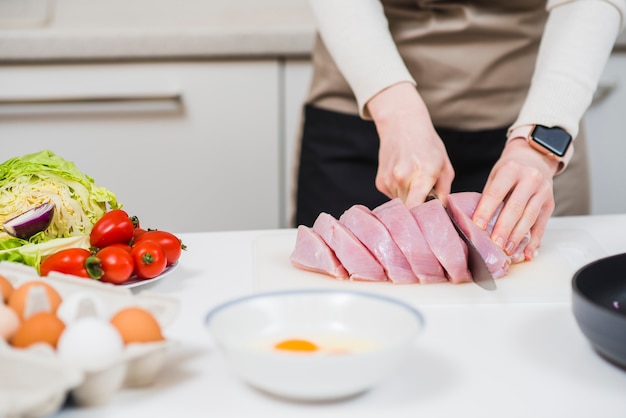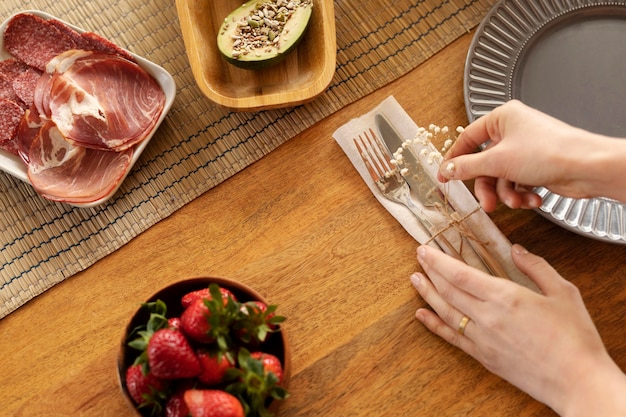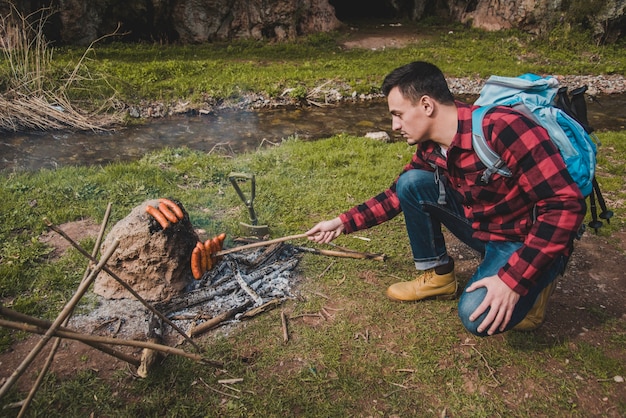I'll never forget the first time I roasted a pig in the ground. It was a summer afternoon, the air thick with anticipation, and a group of us were gathered around a pit we'd spent hours digging. As we lowered the seasoned pig into the earth, a sense of accomplishment mixed with excitement filled the air. It wasn't just about the food; it was about the experience, the shared effort, the sense of community. Roasting a pig in the ground is more than just a meal; it's an event, a tradition, a memory in the making.
Now, I know what you're thinking. "That sounds complicated," you might say. And you're not wrong. It's not a quick and easy recipe, but I promise, with a bit of planning, a good group of friends, and a whole lot of enthusiasm, it's totally doable. So, grab a cuppa, get comfy, and let's dive into this whole hog adventure.
(Part 1) Choosing Your Pig: The Foundation of Flavour

The Perfect Pig: Weighing Your Options
First things first, we need a pig! Now, you've got a few choices here. You could go for a farm-raised pig, which is the most common choice. You can often find them pre-butchered, making the process a bit easier. If you're feeling a bit more adventurous, you could consider a heritage breed. These pigs are known for their unique flavours and tenderness. However, you might have to do some extra research to find a butcher who works with them.
Whatever your choice, make sure the pig has been slaughtered and chilled. This is crucial for food safety and will make the cooking process smoother. You want your pig to be already dressed for the occasion, so to speak. And remember, the pig should be delivered chilled, not frozen. A frozen pig won't cook evenly.
Size Matters: How Big is Big Enough?
The size of the pig is crucial. You need to consider how many people you're feeding. A good rule of thumb is about 1.5 kg (3.3 lbs) per person, though you can always round up if you're planning on having leftovers. But don't go overboard. A huge pig might be a bit intimidating, and you don't want to end up with more food than you can handle. Also, remember to factor in the bones and fat, which won't be edible. You'll also want to consider the size of your pit. You don't want a pig that's bigger than the hole you've dug!
(Part 2) Preparing the Pit: Your Culinary Crucible

Digging Your Destiny: Choosing the Spot
Alright, so you've got your pig, now it's time to find the perfect spot for your pit. You need a location that's level, away from any trees or structures, and ideally in a spot that gets good airflow. This will help with the smoke management and prevent any unwanted smoke damage to your surroundings. It's also a good idea to check with your local council about permits or regulations before you start digging. You don't want to end up with a surprise visit from the authorities, do you?
A Hole in the Ground: Creating Your Culinary Crucible
The pit itself is the heart of the operation. Aim for a hole that's big enough to accommodate the pig with a good amount of space around it. The depth should be around 60 cm (2 ft) – you'll be layering a lot of stuff in there. I usually use a shovel, but you could also use a post hole digger for the initial part. Just make sure the walls are straight and sturdy, and the bottom is level. You don't want your pig to tilt over while cooking! And don't forget about drainage. You don't want your pit to turn into a soggy mess. A bit of gravel at the bottom can help with drainage.
(Part 3) Laying the Foundation: Building the Fire

Heating Up the Earth: Creating the Ideal Cooking Environment
Once your pit's ready, it's time to build the fire. This is where things get exciting! You need a good, hot fire, but you also want to make sure the wood you're using doesn't impart too much of a strong flavour to the pig. Hardwoods like oak, hickory, or applewood are generally preferred. They provide a smoky flavour without being overpowering. For a good, long burn, I like to start with a big pile of kindling, then gradually work my way up to larger pieces of wood. It's a good idea to have a few different sizes on hand so you can adjust the heat as needed.
Fire Control: Keeping the Heat Steady
You want the fire to be roaring for about two hours. This will help to heat the ground and create the ideal cooking environment. You need to keep an eye on the flames, and if they start to die down, add more wood. Don't let the fire burn out! It's a good idea to have a few helpers on hand, especially if you're dealing with a larger fire. They can help with fetching wood, monitoring the flames, and generally ensuring the fire keeps going strong.
(Part 4) Wrapping the Pig: The Art of the Roast
Seasoning and Savour: Infusing Flavour into Your Pig
Alright, the fire has burned down, and the coals are glowing. Now, it's time to prep the pig. This is where your creativity can really shine. You can choose any kind of seasoning you like. I'm a big fan of simple rubs made with salt, pepper, garlic powder, and onion powder. You can also get fancier with herbs, spices, and even a little bit of chili powder. Don't be afraid to experiment! Try a blend of paprika, cumin, and oregano for a Spanish-inspired flavour, or add some cayenne pepper for a touch of heat. It's all about finding what you love.
The Protective Shell: Covering Your Culinary Creation
Next, you need to wrap the pig. This is where the magic truly happens. You're going to create a protective shell that traps in the heat and moisture, allowing the pig to cook evenly. I use a combination of foil and heavy-duty butcher paper. First, I wrap the pig tightly in foil, making sure to seal the edges. Then, I cover the whole thing with a layer of butcher paper, sealing it with string. The paper helps to prevent the foil from sticking to the pig, and it also absorbs any excess moisture. You can even add a few slices of apple or onion inside the foil packet for extra flavour.
(Part 5) Lowering the Pig: A Ceremony of Fire and Earth
The Great Descent: Laying the Pig to Rest
Now comes the exciting part: lowering the pig into the pit. This is a job that requires a few strong hands. Carefully lift the wrapped pig and slowly lower it into the pit. You want to make sure it's centered and level, and you don't want to disturb the hot coals. Once the pig is in place, you can cover the pit with a thick layer of dirt. This will help to trap the heat and cook the pig evenly. I usually use a few shovels of dirt to seal up the top, and then I cover it with a few thick pieces of plywood to prevent the heat from escaping.
The Countdown Begins: Patience is a Virtue
Now, you're going to have to wait. And I mean wait a long time. The cooking time depends on the size of the pig, but generally, you're looking at around 6-8 hours. The idea is to let the pig cook slowly and evenly, so don't rush it. You can check the progress by using a meat thermometer. Insert it into the thickest part of the thigh, avoiding the bone. You want to make sure the internal temperature reaches at least 71°C (160°F) for safety. This ensures the pig is cooked through and safe to eat.
(Part 6) The Big Reveal: Unearthing Your Culinary Masterpiece
The Moment of Truth: Unveiling the Roasted Pig
After hours of anticipation, it's finally time to unveil your culinary masterpiece. Gather your friends and family around, and prepare to be amazed. Start by removing the plywood cover, then carefully dig away the dirt until you can see the top of the pig. It's a good idea to have a few shovels on hand to help with the digging. You'll also want to wear gloves, as the earth will be very hot. As you uncover the pig, the aroma of smoky pork will fill the air, building anticipation for the feast to come.
Feasting on the Bounty: Enjoying the Fruits of Your Labor
Once you've uncovered the pig, carefully lift it out of the pit. You'll likely want to use a few strong arms for this. Set it aside and let it rest for a few minutes before slicing it open. When you're ready, slice the pig open, and let the aromas of delicious, smoky pork fill the air. This is a moment to savor. You've just created a culinary experience that's as much about the journey as it is about the destination. Gather your friends and family, and dig in!
(Part 7) side dishes: Complementary Delights
The Perfect Pairings: Balancing Flavour and Texture
Of course, no roast pig feast is complete without some delicious side dishes. You want to choose dishes that complement the rich, smoky flavour of the pork. I always serve a variety of salads, including coleslaw, potato salad, and a simple green salad with a vinaigrette dressing. The coleslaw adds a refreshing tang, the potato salad provides a creamy counterpoint, and the green salad brings a light touch of freshness. You could also serve corn on the cob, baked beans, or even a baked potato bar. The key is to offer a range of flavours and textures to balance out the richness of the pig. A good side dish will enhance the overall experience and make the feast memorable.
(Part 8) Tips and Tricks: Mastering the Art of the Ground Roast
Food Safety First: Prioritizing Safe Practices
Remember, food safety is paramount. Make sure you're using fresh, high-quality ingredients, and always follow proper food handling techniques. Keep the pig refrigerated until you're ready to cook it, and make sure it's fully cooked before serving. You can use a meat thermometer to check the internal temperature. The USDA recommends a safe internal temperature of 71°C (160°F) for pork. It's also important to wash your hands thoroughly before and after handling the pig and any of the cooking equipment.
Beyond the Basics: Exploring Variations and Innovations
Don't be afraid to experiment! You can use different types of wood for your fire, try different seasonings, and even add other ingredients to your pit, like apples, onions, or potatoes. The possibilities are endless. Just remember to keep it simple and focus on the core flavours of the pork. And above all, have fun! The beauty of roasting a pig in the ground is that it's a collaborative effort. Get everyone involved, let them contribute their ideas, and enjoy the process. After all, the best feasts are the ones filled with laughter, good company, and a shared love for good food.
FAQs
What kind of wood should I use for the fire?
For a traditional roast pig, hardwoods like oak, hickory, or applewood are best. They impart a smoky flavour without being overpowering. Avoid softwoods like pine or fir, as they can give the pig a resinous taste. If you're looking for a sweeter smoke, consider using fruitwood like cherry or apple. The choice of wood will influence the final flavour of the pig, so choose wisely.
How long does it take to roast a pig in the ground?
The cooking time depends on the size of the pig, but generally, you're looking at around 6-8 hours. Make sure you use a meat thermometer to check the internal temperature. You want to make sure the internal temperature reaches at least 71°C (160°F) for safety. It's better to overcook a pig slightly than to undercook it. Remember, patience is key! Let the pig cook slowly and evenly for the best results.
What if my pig is too small or too big for my pit?
If your pig is too small, you can adjust the cooking time. If it's too big, you might need to find a larger pit. It's important to have enough space for the pig to cook evenly. If you're worried about the size, it's always best to err on the side of a slightly larger pig. It's easier to adjust the cooking time than it is to find a bigger pit at the last minute.
Can I add other ingredients to the pit?
Yes, you can! You can add vegetables like apples, onions, or potatoes. They'll absorb the smoky flavour and add a nice touch to the meal. Just make sure to wrap them separately so they don't get stuck to the pig. You can also add herbs and spices to the pit. Try rosemary, thyme, or sage for a classic flavour profile. The possibilities are endless! Just remember to keep the flavours simple and let the natural flavour of the pig shine through.
What should I do with the leftovers?
Leftover roast pig is delicious! You can use it to make sandwiches, salads, or even a hearty stew. It also freezes well, so you can enjoy it later. Just remember to reheat it thoroughly before serving. If you have a lot of leftovers, consider making a pig roast pizza. Just use the leftover meat as a topping on your favourite pizza dough. It's a delicious and creative way to use up leftovers and enjoy the flavours of your feast again.
Everyone is watching

How to Cook Frozen Lobster Tails Perfectly: A Step-by-Step Guide
RecipesLobster. Just the word conjures up images of lavish meals, special occasions, and a taste of luxury. But let's...

Pigs in a Blanket Cooking Time: How Long to Bake for Perfect Results
RecipesAh, pigs in a blanket. Just the name conjures up images of those delightful little parcels of crispy pastry en...

Pork Fillet Cooking Time: How Long to Cook It Perfectly
RecipesPork fillet, or tenderloin as it's sometimes called, is a real favourite in our house. It's so versatile, and...

The Ultimate Guide to Cooking Delicious Frankfurters
RecipesLet's face it, we all love a good frankfurter. It's a classic, simple, and always satisfying. But let's be rea...

Wolf Meat Recipes: A Guide to Cooking Wild Game
RecipesLet's be honest, you don't see wolf meat at your local butcher shop every day. It's a bit of a wild card, but ...
